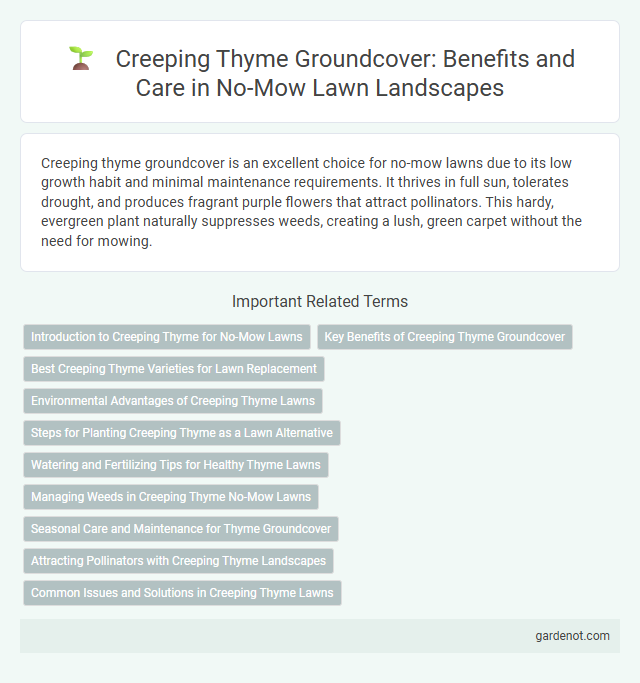Creeping thyme groundcover is an excellent choice for no-mow lawns due to its low growth habit and minimal maintenance requirements. It thrives in full sun, tolerates drought, and produces fragrant purple flowers that attract pollinators. This hardy, evergreen plant naturally suppresses weeds, creating a lush, green carpet without the need for mowing.
Introduction to Creeping Thyme for No-Mow Lawns
Creeping thyme is a low-growing, drought-resistant groundcover ideal for no-mow lawns, thriving in full sun and well-drained soil. This aromatic perennial produces dense mats of tiny, green leaves and vibrant purple flowers that attract pollinators and require minimal maintenance. Its natural ability to suppress weeds and tolerate light foot traffic makes creeping thyme a sustainable and attractive alternative to traditional grass lawns.
Key Benefits of Creeping Thyme Groundcover
Creeping thyme groundcover offers exceptional drought tolerance and thrives in poor soils, making it a low-maintenance alternative to traditional grass lawns. It attracts pollinators like bees and butterflies, enhancing biodiversity and supporting a healthy garden ecosystem. This aromatic groundcover also resists weeds naturally and releases a pleasant fragrance when walked upon, combining beauty with functionality.
Best Creeping Thyme Varieties for Lawn Replacement
Creeping thyme varieties such as Thymus serpyllum 'Elfin,' Thymus serpyllum 'Pink Chintz,' and Thymus praecox 'Arctic Snow' are excellent choices for lawn replacement, offering low-maintenance, drought-tolerant groundcover. These varieties feature dense, aromatic foliage and vibrant blooms that attract pollinators while suppressing weeds. Their ability to thrive in full sun and poor soil conditions makes them ideal for sustainable, no-mow lawns.
Environmental Advantages of Creeping Thyme Lawns
Creeping thyme lawns significantly reduce water usage due to their drought tolerance, making them an eco-friendly alternative to traditional grass. Their dense, low-growing habitat supports pollinators like bees and butterflies, boosting local biodiversity. Additionally, creeping thyme naturally suppresses weeds and requires minimal mowing, lowering carbon emissions from lawn maintenance equipment.
Steps for Planting Creeping Thyme as a Lawn Alternative
Select a sunny location with well-drained soil to plant creeping thyme as a low-maintenance lawn alternative. Prepare the soil by removing weeds and loosening the surface, then spread creeping thyme seeds or plugs evenly over the area, lightly pressing them into the soil. Water the planting area consistently during the first few weeks to ensure strong root establishment and dense ground coverage.
Watering and Fertilizing Tips for Healthy Thyme Lawns
Creeping thyme, a drought-tolerant no-mow lawn option, requires minimal watering once established, thriving best with deep, infrequent watering to encourage strong root growth. Fertilize creeping thyme lawns sparingly using a balanced, slow-release fertilizer in early spring to maintain vibrant foliage without promoting excessive growth. Overwatering and excessive fertilization can weaken thyme plants, making them susceptible to disease and reducing their drought resilience.
Managing Weeds in Creeping Thyme No-Mow Lawns
Creeping thyme serves as an effective groundcover for no-mow lawns by naturally suppressing weed growth through its dense, low-growing mat. Its ability to thrive in well-drained soil and full sun conditions minimizes bare patches where weeds typically establish. Regularly maintaining creeping thyme with occasional trimming encourages vigor, reducing weed competition and promoting a lush, weed-resistant landscape.
Seasonal Care and Maintenance for Thyme Groundcover
Creeping thyme groundcover thrives with minimal maintenance, requiring well-drained soil and full sun exposure to promote dense growth. Seasonal care involves light pruning in early spring to remove dead stems and encourage new shoots, while occasional watering during prolonged dry spells helps sustain health. Mulching in colder climates protects roots from frost, and monitoring for pests or fungal diseases ensures long-term vitality.
Attracting Pollinators with Creeping Thyme Landscapes
Creeping thyme groundcover creates an inviting habitat for pollinators such as bees and butterflies by producing abundant, nectar-rich flowers throughout the growing season. Its dense, low-growing foliage offers shelter and a continuous food source, enhancing biodiversity in no-mow lawn landscapes. Integrating creeping thyme supports sustainable gardening practices by promoting pollinator populations essential for ecosystem health.
Common Issues and Solutions in Creeping Thyme Lawns
Creeping thyme groundcover often faces common issues such as drought stress, soil compaction, and weed invasions, which can hinder its growth and coverage. To address these challenges, ensure well-draining soil, provide occasional deep watering during dry spells, and perform light aeration to reduce compaction. Implementing regular manual weed removal and using mulch around the thyme can prevent weed competition and promote healthy, dense growth in no-mow lawns.
Creeping thyme groundcover Infographic

 gardenot.com
gardenot.com